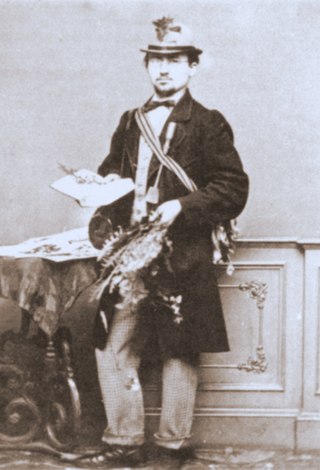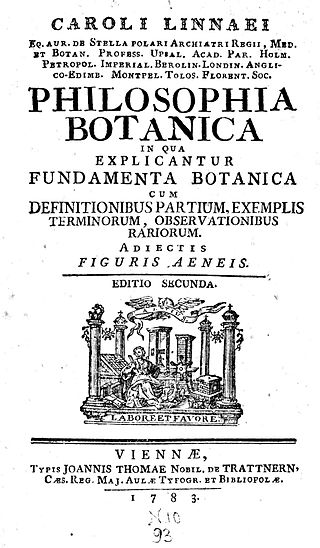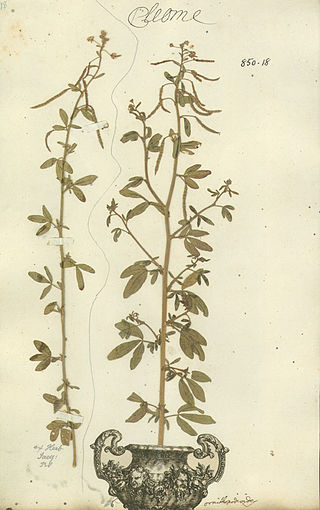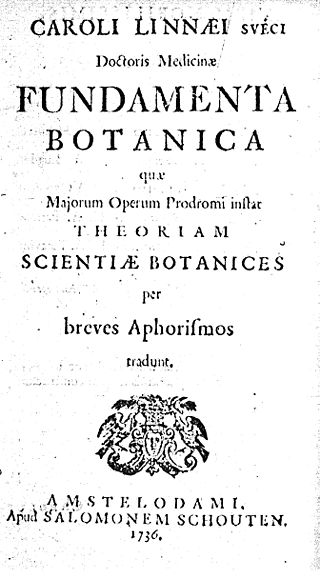
Flora Lapponica (Amsterdam, 1737) [1] is an account of the plants of Lapland written by botanist, zoologist and naturalist Carl Linnaeus (1707-1788) following his expedition to Lapland.

Flora Lapponica (Amsterdam, 1737) [1] is an account of the plants of Lapland written by botanist, zoologist and naturalist Carl Linnaeus (1707-1788) following his expedition to Lapland.
Over the period from 12 May 1732 to 10 September 1732, and with a grant from the Royal Society of Sciences in Uppsala for his journey, [2] [3] Linnaeus was able to combine his interest in medicine with that of natural history to travel for five months in Lapland collecting animals, plants, and minerals.
In Flora Lapponica Linnaeus's ideas about nomenclature and classification were first used in a practical way, making this the first proto-modern flora. [4] The account covered 534 species, used the Linnaean classification system and included, for the described species, geographical distribution and taxonomic notes. It was Augustin Pyramus de Candolle who attributed Linnaeus with Flora Lapponica as the first example in the botanical genre of Flora writing. Botanical historian E.L. Greene described Flora Lapponica as “the most classic and delightful of Linnaeus’s writings”.
A Lapland plant, Linnaea borealis , was named by the eminent botanist Jan Frederik Gronovius in commemoration of Linnaeus's achievements. In the Critica Botanica Linnaeus uses this name to advocate the use of commemorative personal names as botanical names:
it is commonly believed that the name of a plant which is derived from that of a botanist shows no connection between the two...[but]...Linnaea was named by the celebrated Gronovius and is a plant of Lapland, lowly, insignificant, disregarded, flowering but for a brief space — after Linnaeus who resembles it. [5]
An update of this work was published in 1792 by James Edward Smith, citing Linnaeus as the main author and using Linnaeus' binomial nomenclature. [6] These books are not to be confused with Gerog (Göran) Walhenberg's 1812 "Flora Lapponica", who organized species according to their vegetation types and geographic areas. [7]

Carl Linnaeus, also known after ennoblement in 1761 as Carl von Linné, was a Swedish biologist and physician who formalised binomial nomenclature, the modern system of naming organisms. He is known as the "father of modern taxonomy". Many of his writings were in Latin; his name is rendered in Latin as Carolus Linnæus and, after his 1761 ennoblement, as Carolus a Linné.

Linnaean taxonomy can mean either of two related concepts:
In biology, taxonomy is the scientific study of naming, defining (circumscribing) and classifying groups of biological organisms based on shared characteristics. Organisms are grouped into taxa and these groups are given a taxonomic rank; groups of a given rank can be aggregated to form a more inclusive group of higher rank, thus creating a taxonomic hierarchy. The principal ranks in modern use are domain, kingdom, phylum, class, order, family, genus, and species. The Swedish botanist Carl Linnaeus is regarded as the founder of the current system of taxonomy, as he developed a ranked system known as Linnaean taxonomy for categorizing organisms and binomial nomenclature for naming organisms.

Order is one of the eight major hierarchical taxonomic ranks in Linnaean taxonomy. It is classified between family and class. In biological classification, the order is a taxonomic rank used in the classification of organisms and recognized by the nomenclature codes. An immediately higher rank, superorder, is sometimes added directly above order, with suborder directly beneath order. An order can also be defined as a group of related families.

Linnaea borealis is a species of flowering plant in the family Caprifoliaceae. Until 2013, it was the only species in the genus Linnaea. It is a boreal to subarctic woodland subshrub, commonly known as twinflower.

Species Plantarum is a book by Carl Linnaeus, originally published in 1753, which lists every species of plant known at the time, classified into genera. It is the first work to consistently apply binomial names and was the starting point for the naming of plants.

Carl Ernst Otto Kuntze was a German botanist.
Jane Colden was an American botanist, described as the "first botanist of her sex in her country" by Asa Gray in 1843. Although not acknowledged in contemporary botanical publications, she wrote a number of letters resulting in botanist John Ellis writing to Carl Linnaeus of her work applying the Linnaean system of plant identification to American flora, for which botanist Peter Collinson stated "she deserves to be celebrated". Contemporary scholarship maintains that she was the first female botanist working in America, which ignores, among others, Maria Sibylla Merian or Catherine Jérémie. Colden was respected as a botanist by many prominent botanists including John Bartram, Peter Collinson, Alexander Garden, and Carl Linnaeus. Colden is most famous for her untitled manuscript, housed in the British Museum, in which she describes the flora of the Hudson Valley in the Newburgh region of New York state, including ink drawings of 340 different species.

Linnaea is a plant genus in the honeysuckle family Caprifoliaceae. Until 2013, the genus included a single species, Linnaea borealis. In 2013, on the basis of molecular phylogenetic evidence, the genus was expanded to include species formerly placed in Abelia, Diabelia, Dipelta, Kolkwitzia and Vesalea. However, this is rejected by the majority of subsequent scientific literature and flora.

Philosophia Botanica was published by the Swedish naturalist and physician Carl Linnaeus (1707–1778) who greatly influenced the development of botanical taxonomy and systematics in the 18th and 19th centuries. It is "the first textbook of descriptive systematic botany and botanical Latin". It also contains Linnaeus's first published description of his binomial nomenclature.

Johannes Browallius, also called John Browall, was a Finnish and Swedish Lutheran theologian, physicist, botanist and at one time friend of Swedish taxonomist Carl Linnaeus.

Cultivated plant taxonomy is the study of the theory and practice of the science that identifies, describes, classifies, and names cultigens—those plants whose origin or selection is primarily due to intentional human activity. Cultivated plant taxonomists do, however, work with all kinds of plants in cultivation.

Cleome ornithopodioides or bird spiderflower is the type species of the genus Cleome which is part of the family Cleomaceae or Brassicaceae. The species epithet means "birds-foot like".

Genera Plantarum is a publication of Swedish naturalist Carl Linnaeus (1707–1778). The first edition was issued in Leiden, 1737. The fifth edition served as a complementary volume to Species Plantarum (1753). Article 13 of the International Code of Nomenclature for algae, fungi, and plants states that "Generic names that appear in Linnaeus' Species Plantarum ed. 1 (1753) and ed. 2 (1762–63) are associated with the first subsequent description given under those names in Linnaeus' Genera Plantarum ed. 5 (1754) and ed. 6 (1764)." This defines the starting point for nomenclature of most groups of plants.

The bibliography of Carl Linnaeus includes academic works about botany, zoology, nomenclature and taxonomy written by the Swedish botanist Carl Linnaeus (1707–1778). Linnaeus laid the foundations for the modern scheme of binomial nomenclature and is known as the father of modern taxonomy. His most famous works are Systema Naturae which is considered as the starting point for zoological nomenclature together with Species Plantarum which is internationally accepted as the beginning of modern botanical nomenclature.

Critica Botanica was written by Swedish botanist, physician, zoologist and naturalist Carl Linnaeus (1707–1778). The book was published in Germany when Linnaeus was 29 with a discursus by the botanist Johannes Browallius (1707–1755), bishop of Åbo. The first edition was published in July 1737 under the full title Critica botanica in qua nomina plantarum generica, specifica & variantia examini subjiciuntur, selectoria confirmantur, indigna rejiciuntur; simulque doctrina circa denominationem plantarum traditur. Seu Fundamentorum botanicorum pars IV Accedit Johannis Browallii De necessitate historiae naturalis discursus.

Fundamenta Botanica was one of the major works of the Swedish botanist, zoologist and physician Carl Linnaeus (1707–1778) and issued both as a separate work and as part of the Bibliotheca Botanica.

Bibliotheca Botanica is a botany book by Swedish naturalist Carl Linnaeus (1707–1778). The book was written and published in Amsterdam when Linnaeus was twenty-eight and dedicated to the botanist Johannes Burman (1707–1779). The first edition appeared in 1736 with the full title Bibliotheca Botanica recensens libros plus mille de plantis huc usque editos secundum systema auctorum naturale in classes, ordines, genera et species; it was an elaborate classification system for his catalogue of books.

Commemoration of Carl Linnaeus has been ongoing for over two centuries. Celebrated for his scientific work, Linnaeus was knighted and granted nobility in life. After his death, he has been featured in sculpture, on postage stamps and banknotes, as well as by a medal from the eponymous Linnean Society of London. Several notable people have the given names Linnaeus/Linné or Linnea/Linnéa. Among other things named in his honor are plants, astronomical features, towns, an arboretum, a mineral and a university.

The expedition to Lapland, the northernmost region in Sweden, by Carl Linnaeus between May and October 1732 was an important part of his scientific career.